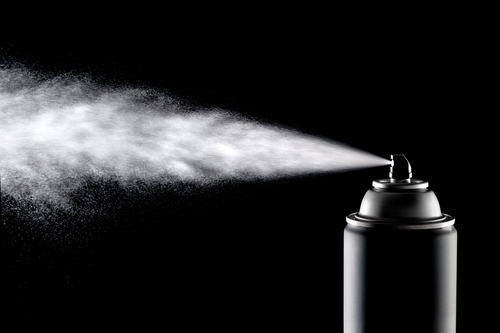Are your workers exposed to hazardous concentrations of airborne chemicals? How do you know? If you don’t know, how can you find out?
 |
Airborne exposures may occur in and around operations that involve:
- Dust generation
- Combustion or work done at high temperatures
- Solvents, especially when used in liquid or spray processes
- Melting metal or treating metal surfaces
Immediate Feedback
A chemical’s presence in the work environment doesn’t necessarily tell you how much of it is getting into the air. To find out whether a hazardous chemical used in your workplace is present in the air your workers breathe, you should begin with sampling to detect and quantify it. This type of sampling, called "grab" sampling, also determines the chemical’s highest airborne concentrations and where you have potential problems.
Grab sampling can be done simply and cheaply with many different types of instruments, including:
- Photoionization detectors (PIDs). These instruments can detect and identify a broad range of chemicals and provide a numeric concentration in units of parts per billion (ppb) or parts per million (ppm). They cannot detect some common toxics, such as carbon monoxide or sulfur dioxide.
Your one-stop safety management resource, available 24/7. Go here to take a no-cost site tour or here to try it in your own office! Plus, for a limited time, receive the NEW 2013 EHS Salary Guide.
- Colorimetric detector tubes. These glass tubes, used together with a bellows or plunger-style pump that draws air through them, detect specific chemical substances. They are scaled so that the substance’s concentration in air can be read directly from the tube.
- Substance-specific detectors. Some instruments have been designed to directly measure concentrations of common hazardous chemicals, such as ammonia or chlorine.
These and similar instruments can give you immediate information on airborne concentrations of chemicals in your facility. You can use them to map concentrations at different times of day, in different weather conditions, and during different types of operations. This information can be used to help set priorities for personal exposure sampling.
Quantifying Worker Exposures
Once you know where and when the highest potential exposures exist, you can begin to identify workers for personal exposure sampling. Personal exposure sampling involves collecting a sample of the air the worker is breathing, throughout his or her shift, to determine whether the exposure exceeds published exposure limits.
Your personal exposure sampling strategy can be designed in one of two ways:
- The "maximum risk" employee. If you can identify a worker whose exposure is probably higher than that of all other workers, collect an exposure sample from that worker. If the maximum risk worker is not overexposed, chances are no other workers are overexposed. The maximum risk worker will usually be the worker closest to the chemical source. Choose the maximum risk worker for each operation because separate operations pose different risks.
- Statistically significant number of samples. If you have a group of workers whose risk is substantially similar, you may need to collect multiple samples to develop a clear picture of exposures. To have at least a 90-percent chance, statistically speaking, of sampling any workers whose exposures are extraordinarily high, you should collect samples from at least as many workers as indicated in the table below. If you collect fewer samples, your sampling may not stand up in court. Collect more, and you’ll be incurring unnecessary expenses.
Great news! BLR’s renowned Safety.BLR.com® website now has even more timesaving features. Take our no-cost site tour! Or better yet, try it at no cost or obligation for a full 2 weeks. Plus, for a limited time, receive the NEW 2013 EHS Salary Guide.
The employees should be chosen randomly from the group. You can do this by assigning each worker a number, and using a random-number table (see the NIOSH Occupational Exposure Sampling Strategy Manual) or random-number generating program (available through a web search) to select workers. Because workers have a legal right to know which chemicals they are exposed to at work, you should inform them of the sampling results.
|
Group Size |
Number of Samples |
|
8 |
7 |
|
9 |
8 |
|
10 |
9 |
|
11-12 |
10 |
|
13-14 |
11 |
|
15-17 |
12 |
|
18-20 |
13 |
|
21-24 |
14 |
|
25-29 |
15 |
|
30-37 |
16 |
|
38-49 |
17 |
|
50 |
18 |
Be sure to thoroughly document all sampling activities. Write down results of grab samples, including date, time, location, temperature, and relative humidity; any required instrument calibration; and potential interferences (multiple chemicals can sometimes cause detection interference).
For personal exposure samples, be sure to document the number of workers exposed, how workers were chosen for sampling, instrument calibrations, sampling and analysis methods, how samples were handled, and sample chains of custody.
These documents will show your diligence in characterizing worker exposures and justify the steps you take to protect workers—information that can be critical if OSHA inspects you or workers ask about their exposures.

PingBack from http://www.rimonabantexcellence.com/t.php?aHR0cDovL3NhZmV0eWRhaWx5YWR2aXNvci5ibHIuY29tL2FyY2hpdmUvMjAxMy8wNi8xOS9jaGVtaWNhbF9zYWZldHlfc2FtcGxpbmdfZXhwb3N1cmVzLmFzcHg=